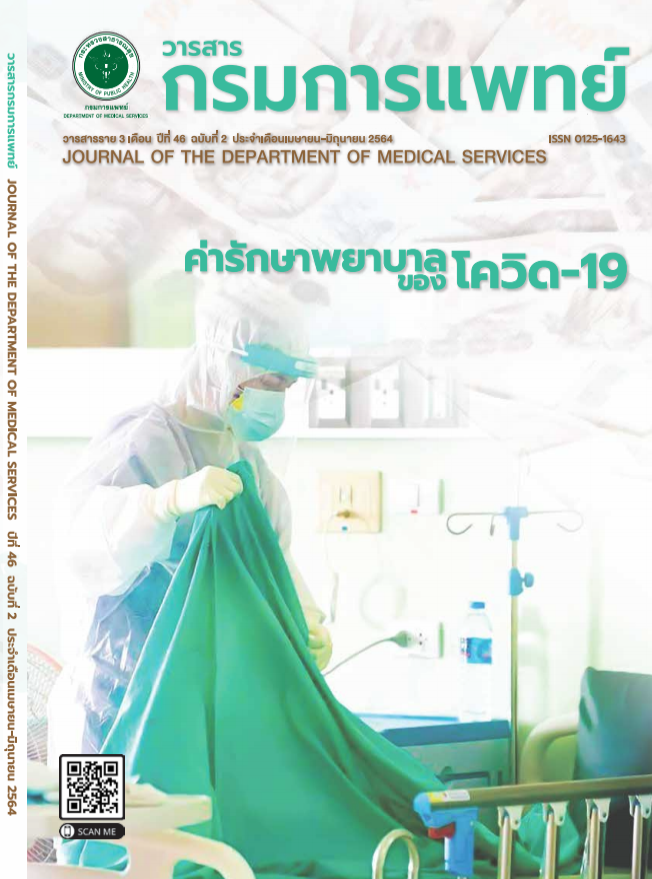Comparison of Compressive Strength of Zirconia Reinforced Glass Ionomer Cement and Amalgam
Keywords:
Compressive strength, Zirconia reinforced glass ionomer cement, Amalgam, Conventional glass ionomer cementAbstract
Background: Currently, the trend of amalgam usage is decreasing, due to the development of adhesive systems and toxicity from mercury, and also the development of tooth-colored restorations materials. Glass ionomer cement is one of the ideal tooth-colored restorative material and has fluoride release to prevent dental caries but the disadvantage is the low compressive strength. Therefore, it has been developed by adding zirconia in glass ionomer cement to increase a high compressive strength.Objective: The aims of this research were to evaluate and compare the compressive strength of restorative material zirconia reinforced glass ionomer cement: Zirconomer Improved, amalgam: Tytin FC®, and conventional glass ionomer cement: GC Gold Label 9 Extra.Method: The 30 cylindrical specimens were fabricated by 4 mm in diameter and 6 mm in height then grouped into six study groups (n=5): group I (Zirconomer Improved at 1 hour), group II (Zirconomer Improved at 24 hours), group III (Tytin FC® at 1 hour), group IV (Tytin FC® at 24 hours), group V (GC Gold Label 9 Extra at 1 hour), group VI (GC Gold Label 9 Extra at 24 hours) for testing the compressive strength. The specimens were tested in a universal testing machine (Instron 5566) at a crosshead speed of 0.5 mm/min for compressive strength until failure occurred. Data analysis and statistical differences were ascertained using one - way ANOVA with Tukey post-hoc test (p<0.05).Result: In 1 hour period, the compressive strength was not different between zirconia reinforced glass ionomer cement and amalgam and was higher than that of conventional glass ionomer cement with statistical significance at the level of 0.05. In the 24 hour period, the compressive strength tests showed a significant difference in 3 groups, the highest compressive strength was exhibited by amalgam followed by zirconia reinforced glass ionomer cement and conventional glass ionomer cement respectively.Conclusion: The addition of zirconia increases the strength of glass ionomer cement significantly compared to the conventional glass ionomer cement and equivalent to amalgam at 1 hour but weaker than amalgam at 24 hours.
References
The 8th National Oral Health Survey, Thailand, 2017. Bureau of Dental Public Health, Department of Health,Ministry of Public Health; 2018.
Anusavice KJ. 1 – Overview of preventive and restorative materials. In: Anusavice KJ, Shen C, Rawls HR, editors.Phillips’Science of Dental Materials. 12th ed. St. Louis, Mo: Elsevier Health Sciences; 2013. p. 3-16.
Murdoch-Kinch CA, McLean ME. Minimally invasive dentistry. J Am Dental Assoc2003;134:87-95.
Khalaf ME, Alomari QD, Omar R. Factors relating to usage patterns of amalgam and resin composite for posterior restorations – a prospective analysis. J Dent 2014;42:785-92.
Dunne SM, Grainsford ID, Wilson NH. Current materials and techniques for direct restorations in posterior teeth. Part 1: Silver amalgam. Int Dent J. 1997;47:123–36.
Nicholson J, Czarnecka B. 2 - Classification of restorative materials and clinical indications. In: Nicholson J,Czarnecka B,editors. Materials for the Direct Restoration of Teeth: Woodhead Publishing; 2016. p. 21-36.
Berg JH. Glass ionomer cements. Pediatric dentistry 2002;24:430-8.
Moshaverinia A, Ansari S, Movasaghi Z, Billington RW, Darr JA,Rehman IU. Modification of conventional glass-ionomer cements with N-vinylpyrrolidone containing polyacids, nano-hydroxy and fluoroapatite to improve mechanical properties. Dent Mater 2008;24:1381–90.
Upadhya PN, Kishore G. Glass ionomer cement - The different generations. Trends in Biomaterials and Artificial Organs 2005;18:158-65.
Walls AWG. Glass polyalkenoate (glass-ionomer) cements: a review. J Dent 1986;14:231-46.
Denry I, Kelly JR. State of the art of zirconia for dental applications. Dent Mater 2008;24:299-307.
Abdulsamee N, Elkhadem AH. Zirconomer and Zirconomer Improved (White Amalgams): Restorative Materials for the Future.[Review]. EC Dental Science 2017;15:134–50.
International organization for standardization. ISO 9917-1:2003 Dentistry -- Water based cements -- Part 1:Powder/liquid acid-base cements; 2003.
Pereira LC, Nunes MC, Dibb RG, Powers JM, Roulet JF, Navarro MF. Mechanical properties and bond strength of glass-ionomer cements. J Adhes Dent 2002;4:73-80.
Bresciani E, Barata Tde J, Fagundes TC, Adachi A, Terrin MM,Navarro MF. Compressive and diametral tensile strength of glass ionomer cements. J Appl Oral Sci 2004;12:344-8.
Dheeraj M, Johar S, Jandial T, Sahi H, Verma S. Comparative Evaluation of Compressive Strength and Diametral Tensile Strength of Zirconomer with GIC and Amalgam. J Adv Med Dent Scie Res 2019;7:52-6.
Chalissery VP, Marwah N, Almuhaiza M, AlZailai AM, Chalisserry EP, Bhandi SH, et al. Study of the Mechanical Properties of the Novel Zirconia-reinforced Glass lonomer Cement. J Contemp Dent Pract 2016;17:394-8.
International organization for standardization. ISO 24234: 2004.Dentistry - Mercury and alloys for dental amalgam; 2004.
Iguodala-Cole BO, Aboush YEY, Vowles RW, Elderton RJ.Challenging the ISO and BSI specifications for glass-ionomer cements: Effect of specimen size upon compressive and tensile strength measurements. Clinical Materials 1991;7:333-4.
Mallmann A, Ataide JC, Amoedo R, Rocha PV, Jacques LB.Compressive strength of glass ionomer cements using different specimen dimensions. Braz Oral Res 2007;21:204-8.
Nomoto R, McCabe JF. Effect of mixing methods on the compressive strength of glass ionomer cements. J Dent 2001;29:205-10.
Bhatia HP, Singh S, Sood S, Sharma N. A Comparative Evaluation of Sorption, Solubility, and Compressive Strength of Three Different Glass Ionomer Cements in Artificial Saliva: An in vitro Study. Int J Clin Pediatr Dent 2017;10:49-54.
Shetty C, Sadananda V, Hegde M, Lagisetti A, Shetty A, Mathew T, et al. Comparative Evaluation of Compressive Strength of Ketac Molar, Zirconomer, and Zirconomer Improved. Scholars Journal of Dental Sciences 2017;4:259-61.
Bonifacio CC, Kleverlaan CJ, Raggio DP, Werner A, de Carvalho RC, van Amerongen WE. Physical-mechanical properties of glass ionomer cements indicated for atraumatic restorative treatment.Aust Dent J 2009;54:233-7.
Downloads
Published
How to Cite
Issue
Section
License

This work is licensed under a Creative Commons Attribution-NonCommercial-NoDerivatives 4.0 International License.
บทความที่ได้รับการตีพิมพ์เป็นลิขสิทธิ์ของกรมการแพทย์ กระทรวงสาธารณสุข
ข้อความและข้อคิดเห็นต่างๆ เป็นของผู้เขียนบทความ ไม่ใช่ความเห็นของกองบรรณาธิการหรือของวารสารกรมการแพทย์



